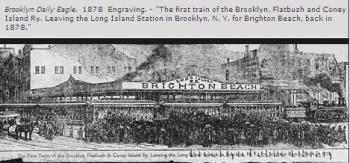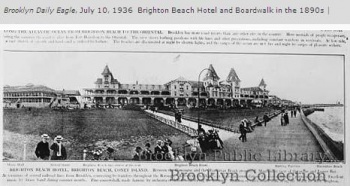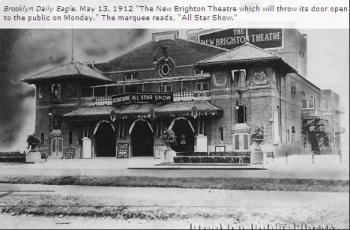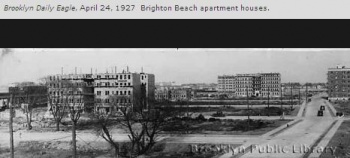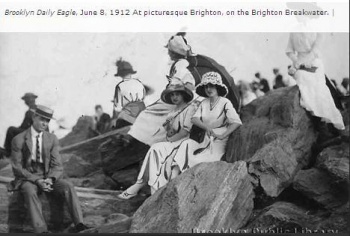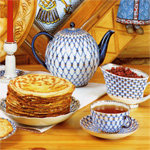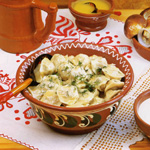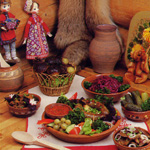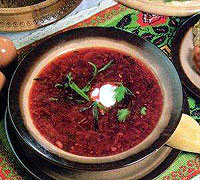The Soviet and Ukranian Communities of Brighton BeachFrom The Peopling of New York City
Brighton Beach Past and PresentBrighton Beach was named after the city of Brighton located on the southern shores of England. Brighton Beach began to develop into a resort area in the late 1870’s by William A. Engeman. Access to the area was improved with the building of a toll road now called Coney Island Avenue. Crowds arrived by stagecoach, steamboats and railroad. A pier to receive steamboats was built in 1869. Railroads included the Brooklyn, Bath and Coney Island Railroad in 1864; the Brooklyn, Flatbush and Coney Island Railroad in 1878 (today's Brighton Beach subway line) and in 1887, the Brooklyn and Brighton Beach Railroad. [1] There were many hotels all along the shore. In 1871 the Ocean Hotel was opened where Brighton Fourth Street meets Brightwater Court today. Then the 2-story Brighton Beach Bathing Pavilion and Ocean Pier, which accommodated 1,200 bathers, were built in 1878. Soon after the 3-story, 174-room Brighton Beach Hotel was built on Coney Island Avenue. This grand hotel became the summer home of the New York Club, the Bullion Club and the Seidl Society, which in September 1889 hosted a luncheon for Susan B. Anthony, the veteran women's rights advocate. [2] Early on, the area attracted the wealthy. The Brighton Theater on Ocean Parkway at Brighton Beach Avenue had high-class variety shows. By 1930 the Brighton Theater would have shows that came directly from Broadway performing on their stage. Adjacent to the Brighton Beach Hotel stood the Brighton Beach Music Hall where Victor Herbert would conduct the symphony orchestra and John Phillip Sousa would play with his marching band. [3] Brighton Beach had one of the finest horseracing tracks in the United States. Horse racing began in Brighton Beach in 1879. William Engeman formed the Brighton Beach Racing Association, with a course located between Ocean Parkway and Coney Island Avenue. The track operated until 1907 when it closed due to new anti-betting laws. By 1910, horse racing had diminished to the point that all tracks were closed. The closing of the racing tracks led to the departure of the wealthy and heralded the demise of the grand hotels. [4] The neighborhood had begun its decline by then but was abruptly uplifted by the sudden arrival of the Russian immigrants. [5] Across from the hotel on Coney Island Ave., the Brighton Baths opened in 1907, a 15-acre wonderland that had 13,000 members at its peak in the 1960’s. [6]It offered such pastimes as swimming in one of three pools, tennis, handball, miniature golf, mah-jongg, card playing, big-name entertainment and a nude beach. For much of the 20th century, it remained a cross between a community gathering place and a beach club. However, as the population became less affluent, the club began to lose members. Despite spirited community protest, the Baths were closed in 1994 and in its place, in 2000, rose the Oceana Condominium and Club, one of the first of many colossal projects to come. [7] Much has changed in the past century in Brighton Beach and the changes continue as we begin a new one. With the development of Oceana on the site of the old Brighton Baths, and the building of a Mets minor league stadium in Coney Island an economic, residential and entertainment resurgence is very much in evidence in the area. Some things have not changed. Mrs. Stahl’s Knishes has been at the same location at the corner of Brighton Beach Avenue and Coney Island Avenue since 1935[8] The story of Brighton Beach as a Russian-speaking enclave began in the late 1960’s. From 1968 through 1971 a few thousand Russian Jews, most from the Ukrainian city of Odessa came to America and settled in Brighton Beach, which reminded them of their hometown on the Black Sea. [9]
Back then, Brighton Beach looked beaten. Most of the stores along Brighton Beach Avenue were closed and the windows papered over. Graffiti was scrawled on storefronts. That was then. The new Brighton Beach is different and many credit the change to the arrival of the Russian immigrants, who upon settling opened up businesses along Brighton Beach Avenue, bringing the end to the decline. Every single storefront is now occupied and the streets are teeming with people. Brighton Beach is quickly gaining a reputation for its wide-variety of restaurants and specialty food stores. Tour buses are double-parked and people come from miles away to get a taste of Russia in Brighton Beach. [10] Brighton Beach Avenue has reemerged in the past 20 years as one of the Brooklyn’s hottest shopping strips, with stores catering to both the Russian residents and the borough at large. Russian books, art and music are available, as well as a plethora of ethnic foods rarely seen outside of Moscow or St. Petersburg. The Avenue boasts some of the finest clothing, fur, and shoe boutiques, which lure the fashionistas of New York with merchandise purchased at fashion shows in Paris and Milan. [11] For the past 30 years the population of Brighton Beach has grown and became more diversified. The drastically increased population of the immigrants from the former Soviet Union was recently joined by the immigrants from Mexico, Pakistan, and Korea to create a multi-cultural neighborhood where everyone continues to live, work, and shop in harmony and piece and where the BID plays a central role as a hub for the development, expansion, and betterment of the community. [12] Photos of Brighton Beach TodaySpotlight: The Soviet Jews in Brighton BeachUntil the Soviet influx, Brighton Beach was primarily inhabited by Yiddish speaking Jews from the first immigration wave. By 1980, Brighton Beach had become the largest Soviet immigrant community in the world. It was dubbed "Little Odessa" because three-quarters of Brighton's immigrants came from Ukraine, from cities around the Black Sea, such as Odessa. In the USSR, Jews were considered to be subordinate citizens. Two main push factors brought the Soviet Jews to America. The first reason was because of the increasingly tight restrictions on the number of Jews allowed in Soviet universities and training schools. Second was the shortage of food, clothing, and housewares. So they came for career opportunities and material sustenance. The first stop for Soviet Jewish emigrants was Vienna. There, they decided to go to either Israel or the U.S. If they chose to come to the U.S., they were flown to Rome by the Hebrew Immigrant Aid Society (HIAS) where they were housed and taught English while their immigration papers were processed. My parents went through this immigration, and the people in Orleck's essay describe this step as my parents do. "In Rome, we got our first taste of the west, and of freedom. We celebrated for three months," one immigrant recalls. After settling in New York, the immigrants were guided by NYANA, or the New York Association for New Americans. The agency came up with several neighborhoods to settle these immigrants, trying to find places with cheap housing, nearby transportation, and already established East European Jewish communities. Among the chosen venues were Brighton Beach, Washington Heights, Rego Park, and Williamsburg. Brighton Beach became the most popular in part for its proximity to the Atlantic Ocean. For immigrants from the Black Sea area, it is comforting to live by the sea and by Brighton's three mile stretch of beach that connects it with Coney Island. One Odessan immigrant said, "The first time I saw the Boardwalk and the beach, I decided I wanted to live here. It reminds me a little of home". The Soviet immigrants in fact changed the face of the old Yiddish community. Along the commercial fifteen blocks that Brighton Beach Avenue runs,Cyrillic letters replaced English and Yiddish ones. Newsstands sell more Russian newspapers than American ones, Russian owned "international style" food stores fill up the avenue, as well as Russian clothing stores, pharmacies, bookstores, and other specialty businesses. The Jewish immigrants from the first and second waves of immigration found ties with the Soviet Jews solely on the reality of being Jewish and having been persecuted for it. But the groups differ in their sense of Jewish identity. Soviet immigrants came from a deeply anti-semetic atmosphere of post World War II Soviet society. The Soviet regime restricted the teaching of Jewish religion or culture. Most people, therefore, knew nothing about their Jewishness, but at the same time they were never allowed to forget they were Jews. Jews were considered to be their own nationality. Soviet passports specified nationality as Russian, Ukrainian, or Jew. Passports were carried everywhere in those times, and having the letter J on an otherwise assimilated Jew's passport would result in harassment from government officials. That J would also keep Jews out of universities and restrict their freedom to travel. Most Jews wanted to escape the Soviet Union and leave the stigma of their Jewishness behind. When they came to Brighton, they experienced the opposite- the American Jews wanted to make them even more Jewish. One first-wave immigrant said, "We fought for them so they could live free as Jews, and here they are, they don't want to be Jews". With the influence of the American Jews, Soviet immigrants began to open up to public displays of Jewishness. For example, they began to publicly celebrate Jewish rites of passage with some attention to Jewish tradition. The details of such observances, however, seem mocking and irreligious to orthodox Jews. These ceremonies hold different meaning for these groups, but the revival of Jewish identity for Soviet Jews is an interesting adaptation of their immigration. Different age groups of Soviet immigrants relate to their Jewish identity and Soviet background in different ways. The transition to Brighton Beach was easiest for the elderly bthem Brighton was comfortable both physically and culturally. The elderly were able to socialize with the American Jews because they share a common language- Yiddish. Those born before World War II, before Stalin went full force in his anti- Jewish campaigns, spoke Yiddish. Although the elderly have not spoken it since the war, they were still able to remember it and used it to communicate to non-Russian speaking Jews on Brighton Beach. One Soviet immigrant said, "The first time I heard Yiddish spoken on the street here, I couldn't believe my ears. Then I saw little boys on the street wearing yarmulkes, unafraid, and I cried. Here when I hear Yiddish spoken freely, my heart feels better". Although most Soviet elderly are not religious, most retain a strong sense of secular Jewish identity. Soviet elders have become part of the larger senior citizen community on Brighton and socialize with elderly members of first and second wave groups in cultural organizations such as Shorefront Senior Center. They also socialize among themselves, most famously on the boardwalk or on chairs in front of their buildings. Soviet elders retain a system of child care where grandparents play an important part in bringing up their grandchildren. Grandparents basically take over caring for their grandkids so that the parents would be free to work or relax. This follows a tradition that does not believe in nannies or babysitters. Grandparents get a chance to be close to their families and provide a necessary service to their children. Though adjusting to American life can be hard for some elderly immigrants, Brighton makes the process easier. All seniors are given minimum Social Security benefits and access to reduced-cost senior citizen housing. They settle into a community that offers familiar foods and a familiar language. The middle aged Soviet immigrants have not had it so easy. They are well educated, most either being college or professional institute graduates or have technical training. Coming to America, they thought there would be no problem finding jobs suited to their skills. Coming from a nation that guarantees work for all trained professionals, they were shocked to have to compete for jobs in America. Many of these immigrants have experienced downward mobility in the United States because they lack sufficient knowledge of the English language. Also, licensing requirements differ in the U.S. Many immigrants hare not able to learn enough of the language to pass licensing exams in the U.S. Some Soviet professionals have either been bale to find work because of their English skills or within the Russian speaking community. Others become entrepreneurs. Many have opened up small businesses such as groceries, restaurants, dry cleaners, clothing stores, car services, travel agencies, etc. and hired fellow immigrants to work for them. Many started their businesses by getting loans from Jewish organizations, and Brighton now booms with them. Younger immigrants have had a much easier time adapting to New York. Immigrants who arrive as young children pick up English quickly without a trace of an accent. In fact, they often teach their parents English and act as translators when needed. Few remember much about their home country, and though they may speak Russian at home, they speak English amongst themselves. Most end up succeeding in New York City public schools, and, having a much more accelerated Soviet education, pick up quickly. Adjusting is harder for teenage immigrants, who, already set in their ways, feel they must change to fit in as Americans. The problem with that is, they are confused as to what an "American" is. The ethnic diversity in public schools makes it hard for them to figure out who exactly it is they must emulate to become more American. One teenage immigrant said, "Where are all the Americans? I haven't met any yet". As these young adults become surer of themselves, they develop identities that mix Russian, New York, Jewish, and American elements. Brighton's Russian restaurants provide a place for group gatherings. They are distinct from other kinds of restaurants. They are like private clubs where Soviet immigrants can gather to celebrate occasions or just come out to have a good time. They feature either banquet style or a la carte menus. Live bands with singers entertain guests all night on the dance floor. The music is a mix of contemporary American, Russian, and traditional Jewish songs. Each restaurant caters to a different regional taste, for example Odessa style, Caucus, style, or Uzbek style. These restaurants are the center of Soviet immigrant life. These restaurants stem from Soviet Jewish culture. It was both difficult and dangerous for Jews to gather in groups. These types of restaurants were among the very few places Jews could gather in a relaxed atmosphere. In America, gathering in these restaurants represents freedom and a good life. The restaurants are extravagant in both decor and the large, gourmet spreads of food they serve. Immigrants come to them dressed in fine, expensive clothing, which represents the life for which they came for. The open Jewish gatherings celebrate the freedom, even though they may not be all that Jewish. For example, at a typical Soviet Jewish Bar Mitzvah, the family will perform the ceremony right in the restaurant. Sometimes they will have a reformed rabbi come in, but it is usually just done by the host of the restaurant, however he or she knows how. After the symbolic ceremony and blessings, everyone sits down to eat the non kosher food and dance to traditional Yiddish music. At a Bar Mitzvah Orleck discusses, she has a guest explain the unusual ceremony. He said, "It is possible that we have forgotten everything about the Jewish religion. But we have not forgotten that we are Jews". Brighton is the only Jewish immigrant neighborhood in New York that contains immigrants of the first, second, and third wave Eastern European Jewish immigrants. The interaction and inter-mingling of these groups has produced a unique type of Jewish community life.Brighton Census TractsOriginally Brighton was mostly inhabited with second generation Americans, who moved there after World War I. Over the years many Jews, who fled the oppressions of the Soviet Union fled to Brighton. They were attracted by the Ocean, which reminded them of the Black Sea, and the fact that they could have a free summer vacation by the sea every year while living only a subway ride from work. Today Brighton Beach is a well-known Russian community. Many recent Russian immigrants try to live near it, to ease the shock of living in a new country. From Brighton Beach Back to Ukraine-Photo TourFrom Russia (to Brighton) with LoveThe Russian culture has a long history and many traditions. Music, night life and cuisine carried to the United states, in particular New York City, is the basis of Russian traditions. Brighton Beach also called “Little Odessa” is the center of Russian culture. There we find Russian restaurants, culinary and clothing stores. There are many Russian restaurants, one example, Tatiana, is a classic example of a perfect night for Russians, including traditional Russian dishes, Russian music and dancing. The Russian theater tradition has always been considered one of the great theater traditions in the world, The Millennium Theater is a great oasis of Russian culture in New York. Some of the great Russian theater troupes bring their plays here. You can also catch some of the old pop stars and some of the new music acts of Russia, and Russian comedy. Cuisine Traditional Russian cuisine is an important part of Russian national culture. In times past, grain - wheat, rye, oats and millet - was the main foodstuff in Russia. Russian people were engaged in ploughing since time immemorial and so bread played a very significant part in their diet. The festive table couldn't be imagined without pies and other pasties. Pies were cooked with a cook cereals, all sorts of pancakes and baked puddings. Cattle-breeding was always popular in Russia as was hunting - hence a large choice of meat dishes included those of wild animals and fowl. Large areas covered by woods and forests, especially in the north of Russia, were abundant in berries and mushrooms and this accounted for a wealth of "gifts of the forests" on the Russian table. One should also not forget about the fish courses. Russian cuisine was renowned for diverse delicacies, especially refreshments, made of fish. At the beginning of the nineteenth century Russian cooks derived various sauces and dressings for which French cuisine was famous. These innovations became an important addition to traditional Russian spices - horse-radish and mustard. All of this undoubtedly enriches Russian cookery. Every housewife of any experience has her own recipes for pies, pickles, and sauerkraut. Even more varied is the choice of recipes for mushrooms, one of the most abundant and nourishing gifts. They are fried, pickled, salted, boiled and what not. As the Russian custom has it, a festive table isn't worth this name without a bottle of vodka. Russians are traditionally hearty drinkers, so Russian wheat vodka is the world's best. kvass is the best-known soft drink. Made of brown bread or malted rye flour, it goes down best on a sultry summer day. Some traditional Russian dishes that are popular on Brighton are Julien, a small mushroom casserole, the famous Russian potato salad, also known as Olivier and the well-known Ukrainian Borsht (tomato soup). Julien Ingredients 2 tb unsalted butter 1 pound mushrooms (any kind), cleaned, trimmed, and cut into quarters or sixths, depending on their size 1 small garlic clove, minced 2 tb thinly sliced fresh chives 1/2 c sour cream 3 tb chopped fresh parsley Salt and freshly ground pepper 3/4 c grated cheese Method: Melt the butter in a large heavy skillet over medium heat. Add the mushrooms and sauté, stirring, until most of the liquid they release has evaporated and the mushrooms are nicely browned, about 10 minutes. Stir in the chives and remove from the heat. Preheat the oven to 425 degrees F. Stir in the sour cream and parsley and season to taste with salt and pepper. Divide the mushrooms among 4 or 5 ovenproof ramekins placed on a baking sheet. Salad "Olivier" Ingredients 5 potatoes 3 carrots 4 eggs 1 pound boiled meat 1/2 pound green peas 2-3 dill pickles (you can use fresh cucumbers) salt to your taste 1/2 pound mayonnaise Method: Boil potatoes and carrots in skin (it helps to keep vitamins), then cool them down and peel them. Boil eggs and boil meat. Chop potatoes, carrots, eggs, meat dill pickles into 1/2 inches squares. Add green peas and salt. Trust your own taste, everything must be in proportion. Stir mayonnaise only for the part of salad you are going to eat. It will be kept better without it. Mix the salad and refrigerate for a while. If you want your salad a little tender, mix a part of mayonnaise with an equal part of sour cream.
Ingredients STOCK 1 1/2 lb beef chuck roast boneless 1 lb beef marrow bones 1 lb ham bone meaty 1 each onion large grated 1 each carrot grated 3 qt water 1 each turnip peeled & grated 1 each celery rib w/leaves sliced 3 each dill sprigs 3 each parsley sprigs 12 each black peppercorns whole 4 each bay leaves SOUP 3 each beets large peeled grated 4 each potatos peeled and cubed 1 16 oz plum tomatos skinned & coarsely ch, opped 1 each onion large chopped 1 each carrot sliced 1 each bell pepper chopped 1/4 cup sunflower oil 1 tsp salt 4 cup cabbage shredded 3 tbsp tomato paste 6 each prunes pitted & chopped 1 tsp honey 1 tsp black pepper fresh ground 1/2 cup sour cream or plain yogurt 4 each garlic cloves minced 2 each bacon strips fried & crumbled 2 tbsp parlsey fresh chopped 3 tbsp dill fresh chopped Music Besides the cuisine, the Russian night life is famous for its music and dancing. Many Russian and Ukranian pop stars are famous in New York City. Russian music is known for its fast beats, mainly in the techno genre. Some famous Russian celebrities who performed in the famous Millenium theater are Verka Serducka, Dima Bilan, and Alla Borisovna Pugacheva. Verka Serduchka Dima Bilan <center>
|
